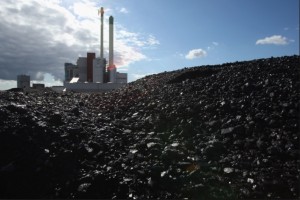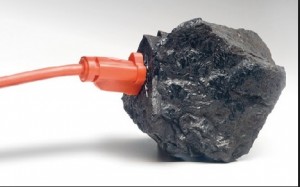On Saturday 15 August, over 1,000 activists from across Europe entered the Garzweiler coal mine in Germany’s Rhineland, bringing operations to a complete halt. The action brought into focus Germany, and indeed Europe’s, coal conundrum – how can the EU move towards to a low-carbon, climate-resilient global economy while the coal sector continues to thrive? Can a truly sustainable Europe be a coal-addicted one?
Lignite – known as brown coal – is the cheapest source of electricity from fossil fuels, and, according to GreenBiz, Germany has the world’s largest reserves of it. However, of all fossil fuels, lignite has the worst impact on the climate, as well making significant contributions to water and air pollution. The lignite mines, including Garzweiler, and the power plants of the Rhineland are the biggest source of CO2 emissions in Europe.
Indeed, GreenBiz attributes the rise of Germany’s CO2 emissions in 2012 and 2013 to an increase in the use of lignite for electricity production. And the trend seems set to continue. In July, there was news of coal-fired Combined Heat & Power (CHP) schemes to be built in Germany and Poland, and a new 660-megawatt power plant that burns lignite is scheduled to be built in Greece by 2020 (backed by the German government-owned development bank KfW). According to Environment and Energy, the deal has come at considerable expense to Germany’s reputation as a climate leader: “By funding the plant in Ptolemaida [in Greece], KfW is helping to block the expansion of renewable energy, such as solar and wind power, while cementing coal-fired power into Greece’s grid for decades.” So, while some other European countries have now decided to end subsidies for coal technology exports, Germany remains the world’s biggest financiers of coal through its export credit agencies.
How can these activities be squared with Germany’s – and Europe’s – green champion rhetoric? Ahead of COP 21 in Paris, EU leaders have agreed to a domestic greenhouse gas reduction target of 40% by 2030 and 80-95% by 2050 (below 1990 levels). The impossibility of pursuing an environmentally sustainable pathway however while constructing new greenhouse gas-spewing coal plants has been long been flagged by environmental activists. “Anyone’s who still thinking of opening new coal mines at this point in time has not been paying attention. The only real question is how fast we can close the ones we already have,” commented 350.org founder Bill McKibben recently. Kiribati President Anote Tong also drew attention to the contradiction in a letter to over 100 world leaders that was published on 13 August. He notes, “The construction of each new coal mine undermines the spirit and intent of any agreement we may reach, particularly in the upcoming COP 21 in Paris, whilst stopping new coal mine constructions NOW will make any agreement reached in Paris truly historical.”
The EU maintains that coal remains a key component in the fuel mix of many countries within the bloc, with conventional thermal generation from fuels such as coal and gas accounting for over half of the EU’s electricity needs. It justifies the use and expansion of coal with the promises of clean coal technologies, such as carbon capture and storage. As the Commission’s dedicated Energy website tells us, “Because a significant amount of power plants and industrial processes will continue to use fossil fuels in the future, the use of carbon capture and storage (CCS) technology is important in helping to decrease greenhouse gas emissions”. Climate Commissioner Arias Cañete noted in a speech in April, “If we get technological development right, combustion would not need to result in harmful emissions of carbon dioxide. Coal needs to be processed more efficiently, to a wider range of finished products, including gas and liquid fuels … My point is that there is a way to ensure that coal investments are not incompatible with the EU’s pathway to a low-emission economy.”
With this in mind, the Commission is placing its hope in research and innovation, doubling research funding on energy to EUR 6 billion in Horizon 2020 and prioritising “pilot projects validation of emerging and innovating technologies leading to efficiency improvements and CO2 emission reduction” under the Research Fund for Coal and Steel (RFCS) Programme for 2015.
However many environmentalists maintain that clean coal is an expensive pipe dream and, as Greenpeace’s Energydesk notes, technologies such as CCS are not even proving to be competitive: “In the last five years 692MW of coal generation has been – or is being – fitted with carbon capture technology … That compares to around 300GW of wind and solar installed over the same period. Even allowing for the fact that the sun doesn’t always shine nor the wind always blow, in deployment terms renewable technologies are out-competing CCS by more than a factor of ten.”
Worse than potentially being ultimately ineffective, the money and effort invested in clean coal technologies may be committing the cardinal sin of distracting us at a time when our efforts are urgently needed elsewhere, namely rapidly bringing renewables on stream and improving energy efficiency. As the Energydesk notes, “Rather than discussing new technological solutions to absorb CO2 from atmosphere, it is perhaps more pragmatic to tackle the big white elephant in the room – improving energy efficiency.”
Truly effective clean coal solutions do not look set to materialise in the short time that we have left to stop catastrophic climate change. So what now can be the justification for Europe’s billowing coal chimneys?
Aoife O’Grady is an Irish, Brussels-based journalist who is the Brussels Correspondent for irish environment




No comments yet, add your own below